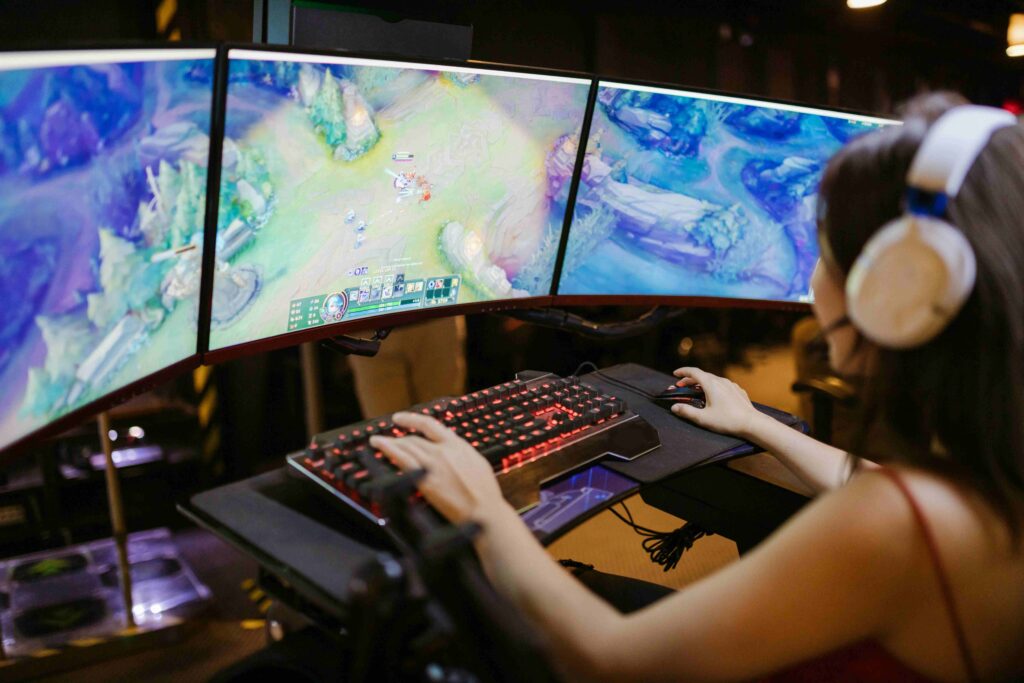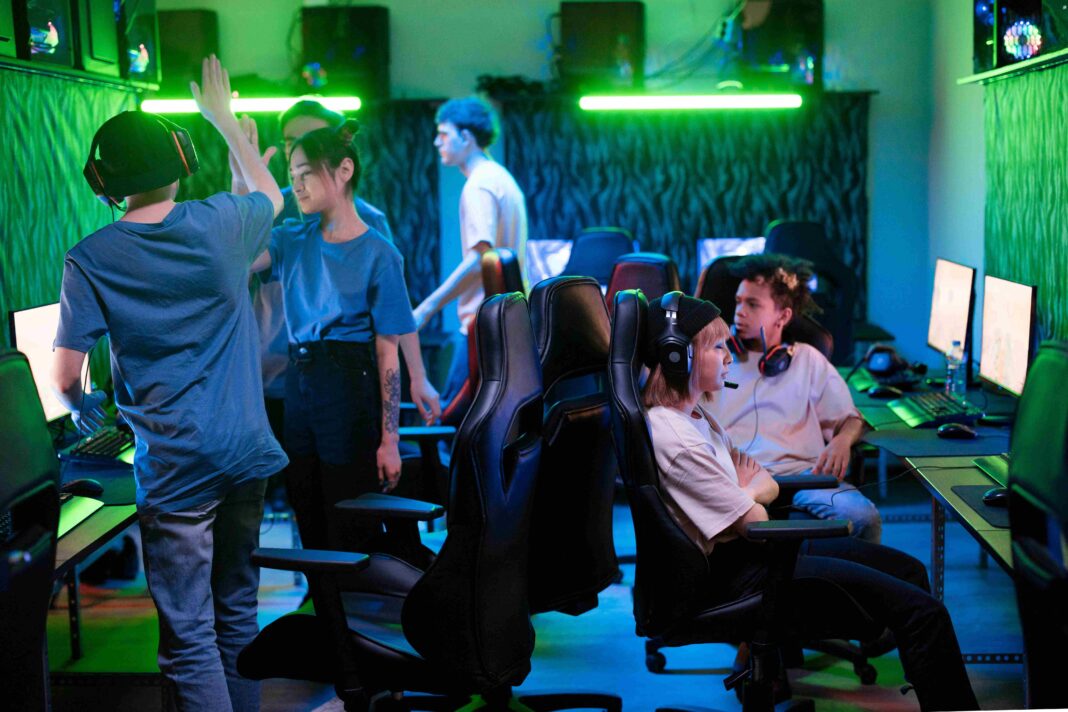For decades, esports was perceived as a male-dominated arena, with women largely sidelined as casual players rather than serious competitors. However, the landscape has shifted dramatically. Female gamers are no longer just participants—they are champions, influencers, and industry leaders driving the future of competitive gaming. From dominating high-stakes tournaments to building massive streaming empires, women are redefining what it means to be a gamer.

This article explores the explosive growth of female gamers in esports, the systemic barriers they continue to face, and the ways the industry is evolving to foster inclusivity. We’ll analyze key trends, spotlight groundbreaking players, and examine what the future holds for women in competitive gaming.
The Growing Presence of Women in Esports
1. The Surge in Professional Female Gamers
Historically, esports tournaments were almost exclusively male. Today, women are not just competing—they are winning. Players like Sasha “Scarlett” Hostyn, a StarCraft II world champion, have shattered stereotypes by defeating top-ranked male opponents. Similarly, Kim “Geguri” Se-yeon became the first female player in the Overwatch League, proving that mechanical skill knows no gender.
The rise of all-female esports teams, such as Team Dignitas Female and CLG Red, has further legitimized women in competitive gaming. These teams participate in major tournaments, often going head-to-head with mixed-gender squads and holding their own.
2. The Streaming Boom: How Female Gamers Are Dominating Content Creation
Platforms like Twitch, YouTube Gaming, and Facebook Gaming have allowed women to bypass traditional esports barriers and build lucrative careers as streamers. Top female streamers like Pokimane, Valkyrae, and Amouranth boast millions of followers, rivaling—and sometimes surpassing—their male counterparts in viewership and sponsorships.
Unlike traditional sports, streaming offers women direct control over their brand, income, and audience engagement. This shift has democratized gaming success, allowing female gamers to thrive without needing approval from male-dominated esports organizations.
3. The Role of Game Developers in Attracting Female Gamers
Game studios have recognized the economic power of female gamers and are actively designing more inclusive experiences. Games like The Last of Us Part II, Horizon Zero Dawn, and Valorant feature strong female protagonists and diverse character customization, making gaming more appealing to women.
Additionally, multiplayer games are implementing stricter anti-harassment measures, such as Riot Games’ “Zero Tolerance” policy for sexist behavior in League of Legends and Valorant. These changes create safer spaces for women to compete without fear of discrimination.
The Challenges Female Gamers Still Face
1. Rampant Online Harassment and Toxicity
Despite progress, female gamers frequently endure sexist slurs, doxxing, and targeted harassment simply for being women in gaming spaces. A 2022 study by the Anti-Defamation League (ADL) found that 59% of female gamers experienced severe harassment, compared to just 28% of male gamers.
Many women resort to avoiding voice chat, hiding their gender, or quitting competitive play altogether due to relentless abuse. High-profile cases, such as the Gamergate controversy, highlight how deeply entrenched misogyny is in gaming culture.
2. The Sponsorship Gap: Why Female Gamers Earn Less
While top male esports players secure multi-million dollar sponsorships from brands like Nike, Red Bull, and Intel, female gamers often struggle to land similar deals. Companies historically assume that male gamers have a larger audience, despite evidence that women drive massive engagement.
Even when female players achieve tournament success, they frequently earn less prize money and lower salaries than male competitors in the same leagues. This pay disparity discourages many talented women from pursuing esports professionally.
3. Stereotypes and the “Gamer Girl” Stigma
Female gamers are often dismissed as “fake gamers” or “attention-seekers”—a stereotype perpetuated by the belief that women only play for clout rather than skill. This stigma leads to:
- Fewer invitations to high-profile tournaments
- Less media coverage of their achievements
- Doubt from peers and sponsors
Players like Mystik (Call of Duty) and Lil Poison (former Madden NFL prodigy) have spoken openly about being underestimated before proving themselves in competition.
4. Lack of Female Representation in Esports Leadership
While women are gaining visibility as players and streamers, they remain severely underrepresented in executive roles. Few women hold positions as:
- Esports team owners
- Tournament organizers
- Game developers
- Industry analysts
This lack of representation means that decisions about inclusivity policies, sponsorship deals, and league structures are often made without female input, perpetuating systemic biases.
How the Industry is Fighting for Inclusivity
1. All-Female Leagues and Tournaments
Organizations like Women in Games International (WIGI) and ESL’s Women’s Circuit have created competitive platforms exclusively for female gamers. These leagues serve as stepping stones, allowing women to gain experience before entering mixed-gender esports.
Critics argue that segregating women reinforces the idea that they can’t compete with men. However, proponents believe these spaces are necessary to build confidence, visibility, and opportunities in an otherwise hostile environment.
2. Stricter Anti-Harassment Policies
Major platforms are finally taking harassment seriously:
- Twitch introduced AI-powered moderation to detect hate speech.
- Riot Games now permabans players for sexist behavior.
- Microsoft’s Xbox Enforcement Team issues instant suspensions for toxic voice chat.
While these measures help, many female gamers argue that enforcement remains inconsistent, and more proactive solutions are needed.
3. Corporate Sponsors Investing in Female Talent
Brands are waking up to the lucrative female gaming market. Companies like Logitech, HyperX, and Secretlab now sponsor top female streamers and esports athletes. Coca-Cola and Nike have also partnered with women-led gaming initiatives, signaling a shift in corporate support.
4. The Rise of Female Esports Commentators and Analysts
Women are increasingly breaking into broadcasting and analysis roles, bringing fresh perspectives to esports coverage. Prominent figures like Ovilee May (League of Legends) and Sue “Smix” Lee (fighting games commentator) have become fan favorites, proving that expertise in gaming isn’t gender-limited.
The Future of Female Gamers in Esports
The trajectory is clear: women are the fastest-growing demographic in gaming, and their influence will only expand. Key trends to watch include:
1. More Women in Shooter and MOBA Esports
Traditionally male-dominated games like Counter-Strike 2, Valorant, and Dota 2 are seeing rising female participation, with all-female teams competing in qualifiers for major events.
2. Mixed-Gender Tournaments Becoming the Standard
As stereotypes fade, expect more women to compete directly against men in premier leagues like the League of Legends Championship Series (LCS) and Call of Duty League (CDL).
3. Greater Focus on Mental Health Support
Female gamers face unique stressors, from online abuse to imposter syndrome. Esports organizations are beginning to offer dedicated mental health resources to help women cope with the pressures of competition.
4. Women Leading the Next Generation of Game Development
With more female game designers entering the industry (e.g., Kim Swift, co-creator of Portal), future games will likely feature better female representation in both characters and storytelling.
FAQ
1. Who are some of the most successful female esports players?
- Sasha “Scarlett” Hostyn (StarCraft II) – First woman to win a major StarCraft II tournament.
- Kim “Geguri” Se-yeon (Overwatch) – First female player in the Overwatch League.
- Katherine “Mystik” Gunn (Call of Duty) – One of the first women to compete professionally in CoD.
2. Why do female gamers get more harassment than male gamers?
Sexism, gatekeeping, and the false belief that gaming is a “male hobby” lead some players to target women to “keep them out” of the space.
3. Will there ever be full gender equality in esports?
Progress is being made, but true equality will require more women in leadership roles, equal pay, and zero tolerance for harassment.
4. How can I support female gamers?
- Subscribe to female streamers
- Call out sexist behavior in games
- Support women-led esports organizations
5. What’s the biggest misconception about female gamers?
That they’re “less skilled” than men. In reality, women have won world championships in games like StarCraft II, Street Fighter, and Counter-Strike.
Conclusion
The rise of female gamers in esports is not just a trend—it’s a movement. Women are breaking records, building empires, and reshaping the industry, but systemic barriers remain. By combating toxicity, demanding equal opportunities, and amplifying female voices, the gaming world can finally become a space where skill—not gender—determines success.
The future of esports is female. The question is: Is the industry ready to embrace it?
Would you like any additional sections, such as case studies of top female players or a timeline of women’s milestones in esports? Let me know how I can expand this further!

